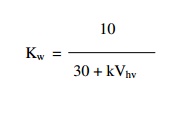Chapter: Design of Electrical Machines : Transformers
Window space factor Kw - Design of Transformers
Window space factor is defined as the ratio of copper area in the window to the area of the window.
For a given window area, as the voltage rating of the transformer increases, quantity of insulation in the window increases, area of copper reduces. Thus the window space factor reduces as the voltage increases.
It depends upon the relative amounts of insulation and copper provided, which in turn depends upon the voltage rating and output o transformers. The following empirical formulae may be used for estimating the value of window space factor:
Kw = 10/(30+kV)
Where kV is the voltage of h.v. winding in kilo-volt. The above formula is for transformers of rating between 50 to 200 kVA.
Space factor is larger for large outputs and smaller outputs. For a transformer of about 1000 kVA rating Kw = 12/(30+kV) and for transformers of about 20 kVA rating Kw = 8/(30 + kV). The values of space actor for intermediate rating can be interpolated.


Related Topics